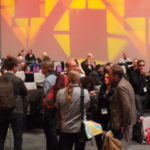
How do you blur the boundary between attendees and panelists? It’s a question that led ACPA — College Student Educators International to introduce a new interactive format called the “Idea Generator” at its 2015 Annual Convention, held at the Tampa Convention Center on March 5–8.
“We wanted to disrupt the traditional setup, where there’s a group of talking heads holding forth onstage for an hour,” said John Dugan, Ph.D., an associate professor of higher education at Loyola University Chicago and the facilitator for the 90-minute Idea Generator session. “ACPA’s executive director [Cindi Love] came up with this format, and it really got a great response at the meeting.”
For the session, a panel of six experts was seated on a raised platform at the front of the room. The topic was “Narrowing the Gap Between What We Learn and What We Do,” and any discussion had to be focused on solutions — not further explorations of the problem. Audience members who wanted to contribute an idea or point of discussion lined up on one side of the platform. Dugan periodically would “tap out” a panelist, who would move to a chair off to the side, and an audience member would take that person’s seat. Experts and audience members could be tapped in and out of the discussion at any point.
“It’s kind of like musical chairs,” Dugan said. “My job was to keep the flow of conversation moving forward and to keep the discussion focused on solutions as people moved in and out of the panel.” One of the biggest challenges of the format was feeling comfortable moving people off the platform quickly. “At first it felt kind of awkward to boot people off the panel,” Dugan said, “but people quickly understood that it wasn’t about the quality of their ideas but about giving more people a chance to contribute.”
What kind of refinements would Dugan make to the format? “When I saw towards the end of the program that we weren’t going to have enough time to get everyone onstage who had lined up, I introduced a couple lightning rounds, where each panelist had three to five minutes to suggest a solution. I think interspersing the lightning rounds earlier would keep the pace moving more evenly and help ensure that everyone gets a chance to contribute.”
The session was livestreamed, and at several points during the discussion Dugan read questions and suggestions from the remote audience to the panel for their response. After the main session was over, ACPA’s Higher Ed Live network interviewed panel participants about the experience and the ideas that resulted from the discussion. “I think the beauty of this format is that it’s very flexible,” Dugan said. “You can use it to create ideas and solutions around any topic and with just about any kind of audience. It’s a great audience-engagement tool.”



